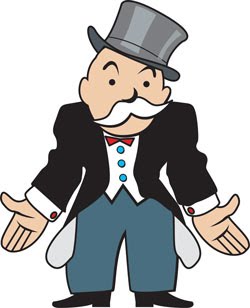 The community policing model becomes completely distorted when policeman – the civil servants you’re most likely to see and interact with in the course of a normal day – are turned into revenue producing instruments by the cities they work for. When a police officer’s job depends on whether s/he can generate enough revenue to keep his employer out of bankruptcy, a lot of people are going to be unhappy. And some of those unhappy people are going to be people grievously harmed, or excessively fined, for behaviour that shouldn’t be a big deal.
The community policing model becomes completely distorted when policeman – the civil servants you’re most likely to see and interact with in the course of a normal day – are turned into revenue producing instruments by the cities they work for. When a police officer’s job depends on whether s/he can generate enough revenue to keep his employer out of bankruptcy, a lot of people are going to be unhappy. And some of those unhappy people are going to be people grievously harmed, or excessively fined, for behaviour that shouldn’t be a big deal.
Mother Jones reporter Jack Hitt offers both thoughts and carefully collected data on this topic in his article, Police Shootings Won’t Stop Unless We Also Stop Shaking Down Black People: The dangers of turning police officers into revenue generators:
There is still no comprehensive study to determine just how many cities pay their bills by indenturing the poor, but it is probably no coincidence that when you examine the recent rash of police killings, you find that the offenses they were initially stopped for were preposterously minor. Bland’s lane change signal, DuBose’s missing plate. Walter Scott had that busted taillight—which, we all later learned, is not even a crime in South Carolina. Eric Garner was selling loose cigarettes. When Darren Wilson was called to look into a robbery, the reason he initially stopped Michael Brown was for walking in the street—in Ferguson, an illegal act according to Section 44-344 of the local code. Between 2011 and 2013, 95 percent of the perpetrators of this atrocity were African American, meaning that “walking while black” is not a punch line. It is a crime.
And not just a crime, but a crime that comes with fines that are strictly enforced.
Hitt points to a disturbing trend in which some towns have created sets of seemingly random and bizarre laws that seem unnecessary – until you look at how much revenue violations of those laws are bringing in for the municipalities. Hitt explains:
“Essentially, these small towns in urban areas have municipal infrastructure that can’t be supported by the tax base, and so they ticket everything in sight to keep the town functioning,” said William Maurer, a lawyer with the Institute for Justice who has been studying the sudden rise in “nontraffic-related fines.”
Take the St. Louis suburb of Pagedale, where, among other Norman Rockwell-worthy features deemed illegal, “you can’t have a hedge more than three feet high,” Maurer says. “You can’t have a basketball hoop or a wading pool in front of a house. You can’t have a dish antenna on the front of your house. You can’t walk on the roadway if there is a sidewalk, and if there is not a sidewalk, they must walk on the left side of the roadway. They must walk on the right of the crosswalk. They can’t conduct a barbecue in the front yard and can’t have an alcoholic beverage within 150 feet of a barbecue. Kids cannot play in the street. They also have restrictions against pants being worn below the waist in public. Cars must be within 500 feet of a lamp or a source of illumination during nighttime hours. Blinds must be neatly hung in respectable appearance, properly maintained, and in a state of good repair.”
Where did this Kafkaesque laundry list come from? Maurer explains that in 2010, Missouri passed a law that capped the amount of city revenue that any agency could generate from traffic stops. The intent was to limit small-town speed traps, but the unintentional consequences are now clear: Pagedale saw a 495 percent increase in nontraffic-related arrests. “In Frontenac, the increase was 364 percent,” Maurer says. “In Lakeshire, it was 209 percent.”
It is probably no coincidence that when you examine the recent rash of police killings, you find that the offenses the victims were initially stopped for were preposterously minor.
This racket now has many variants. South Carolina hosts “Operation Rolling Thunder,” an annual dragnet in which 21 different law enforcement agencies swarm stretches of I-85 and I-26 in the name of catching drug dealers. In 2013, this law enforcement Bonnaroo netted 1,300 traffic citations and 300 speeding tickets. But after everyone had paid up, the operation boasted exactly one felony conviction.
How did we get here?
The sad answer is: Bill Clinton … with the generous help of then-Senator Joe Biden.
Clinton was a “New Democrat” – part of a new coalition of Democrats who believed that the liberalism represented by the New Deal and Great Society had run its course, and that Democrats must court Big Business and certain right-wing interest groups in order to forge a new party.
Included in this policy shift were things like “welfare reform,” the North American Free Trade Agreement, and deregulation of the telecommunications and banking industries. But perhaps Clinton’s earliest and most intense shifting of traditional Democratic Party liberalism was with respect to crime. This took the form of the 1994 Violent Crime Control and Law Enforcement Act (later commonly known as the crime bill). To helm its passage, Clinton tapped none other than our current vice president, then Senator Joe Biden of Delaware.
Joe Biden: Clinton’s Crime Bill Enforcer
Biden was the chief author of the 1994 crime bill, which vastly increased the number of police officers on American streets, eliminated Pell Grants for prisoners, expanded the federal death penalty and upped the Border Patrol presence (recall that this bill was passed around the same time as NAFTA, which increased migration from Mexico).
The bill was passed in a political climate of hysteria about crime and Biden and Clinton used that climate to their advantage. Recall that during the earlier 1992 presidential campaign, Clinton himself flew back to Arkansas during the presidential campaign to ensure a mentally ill black man was executed. Following the execution, Clinton said, “I can be nicked a lot, but no one can say I’m soft on crime.”
That was a sentiment Biden and congressional Democrats also sought to project.

One Reply to “When police become revenue agents to keep towns fiscally solvent”